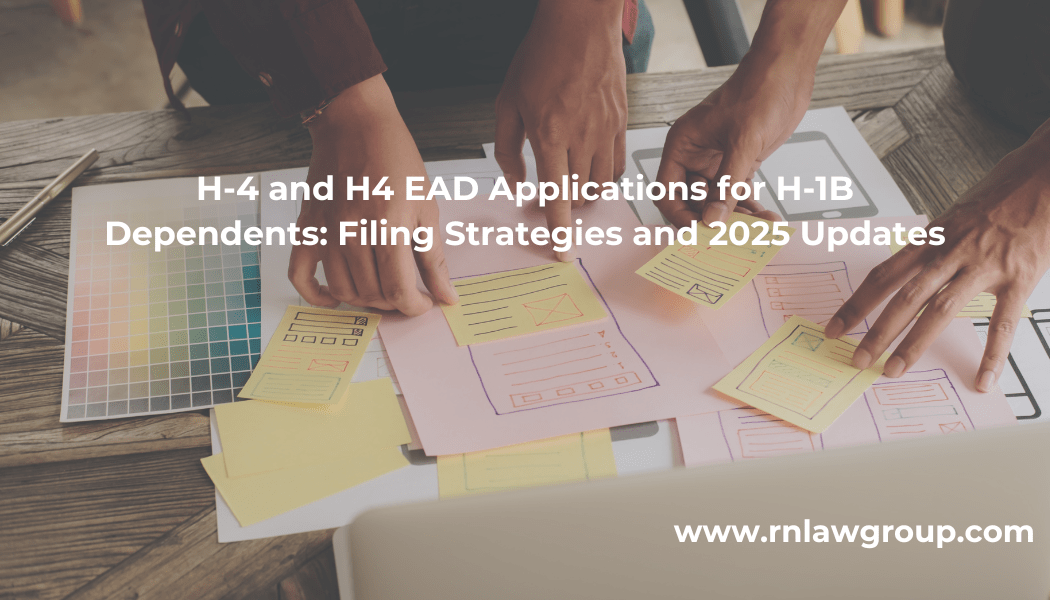
H-4 and H4 EAD Applications for H-1B Dependents: Filing Strategies and 2025 Updates
Understanding the process of filing an H-4 application for dependents H-1B nonimmigrants is critical in the planning and maintenance of the American Dream so many foreign talent upholds. The U.S. immigration system requires meticulous planning to ensure dependent family members maintain their legal status to remain lawfully present in the United States and together with their loved ones. It is essential to stay informed about current regulations and upcoming rule changes that may impact H-4 visa holders, including work authorization policies and processing timelines.
When is an H-4 Application Necessary?
The H-4 visa is available for spouses and foreign-born children of H-1B beneficiaries. It is possible for the H-1B beneficiary’s spouse or children to hold independent nonimmigrant statuses, such as F-1 (student) or their own H-1B employment visa. In these scenarios, filing a change of status to H-4 using USCIS Form I-539 may not be necessary—provided they intend to continue in their existing visa category.
However, for family members of H-1B beneficiaries entering in the H-1B Lottery this fiscal year and who are currently on dependent visas, such as F-2 (dependent of an F-1 student), L-2 (dependent of an L-1 visa holder), TD (dependent of a TN visa holder), or E-3D (dependent of an E-3 visa holder), filing a change of status to H-4 is required before the H-1B status becomes effective on October 1. Similarly, for family members of H-1B beneficiaries who are currently on H4 visa status, they will either need to apply for an H-4 extension of stay via USCIS Form I-539 within 6 months of their expiration date or depart prior to the expiration date of their current visa status and request a new H4 visa directly at a US consulate abroad.
Examples of When an H-4 Application is Required:
- F-2 to H-4: A spouse currently holding F-2 status (dependent of an F-1 student) needs to change to H-4 status when their spouse transitions from F-1 to H-1B employment.
- L-2 to H-4: If an H-1B beneficiary was previously working on an L-1 visa and their spouse had L-2 status, the spouse must change to H-4 once the H-1B is approved.
- E-3D to H-4: A spouse of an Australian E-3 visa holder will need to file for H-4 status once their partner moves to an H-1B position.
- TD to H-4: A child on TD status (dependent of a TN worker from Canada or Mexico) must apply for an H-4 before the TN worker transitions to H-1B.
The Benefits of Filing the H-4 Application Concurrently with the H-1B Petition
Under the terms of the settlement reached in Eadkunni v. Mayorkas by USCIS on January 19, 2023, it became a requirement for USCIS to simultaneously adjudicate a properly file H-4 application if properly bundled with a properly filed H-1B petition in regular or premium processing. The effect of this settlement was that the same processing time was applied to the properly bundled H-4 (Form I-539) and H-4 EAD (Form I-765) as applied to the H-1B petition in the same bundled filing. This change aimed to reduce processing delays and ensure that dependents receive their work authorization without unnecessary disruptions.
Unfortunately, the terms of the Eadkunni v. Mayorkas settlement agreement were set to be valid for a period of two year. As a result, it is very likely that as of January 18, 2025, USCIS may restructure its adjudication policies to allow for the concurrent processing of H-4 dependent applications and their corresponding employment authorization documents (EADs) alongside the primary H-1B petition.
The optimal time to file Form I-539 for H-4 status is concurrently with the principal H-1B applicant’s I-129 petition. Filing together offered several advantages:
- Avoiding Status Gaps: Filing simultaneously ensured that dependents’ applications are processed in line with the H-1B approval timeline, reducing the risk of family members falling out of status.
- Tracking and Processing Benefits: Filing concurrently helped USCIS track dependent applications more efficiently, although H-4 petitions may still take longer to process than H-1B petitions due to the lack of premium processing options for Form I-539.
Now with the terms of the settlement having ended as of January 18, 2025 it is still unclear whether –in practice – USCIS will use their discretion to continue to application of the spirit created by the Eadkunni v. Mayorkas settlement. If USCIS reverts to its previous processing procedures—where dependent applications are handled separately—affected parties should anticipate prolonged processing delays once the agency is no longer bound by the terms of the Eadkunni v. Mayorkas settlement. Such a shift could result in extended wait times for H-4 and L-2 dependents, potentially causing significant employment disruptions for many spouses and their employers, as seen in the past. It is important to note that the settlement does not restrict USCIS’s authority to introduce new regulations, policies, or procedures regarding status extensions or employment authorization documents (EADs) for eligible noncitizens holding valid H-4 or L-2 status.
H-4 Employment Authorization (EAD) Considerations
H-4 visa holders are generally not allowed to work unless eligible for an Employment Authorization Document (EAD). An H-4 EAD can only be obtained if the H-1B principal has reached a qualifying stage in the green card process, such as having an approved I-140 petition. In such cases, the H-4 spouse must file a separate I-765 application for work authorization. This H-4 EAD application may also be filed concurrently with the H-4 visa if the H-4 will be expiring within the next 6 months.
An H-4 dependent with H4 EAD work authorization does not need to reapply or extend their validity periods simply because the H-B beneficiary is changing employers. The basis of their ability to maintain H-4 dependent status is solely based on the H-1B Principal’s maintenance of their H-1B status, not who their employer petitioner is. It can however be convenient to file the H-4 and H-4 EAD applications concurrently bundled with the H-1B beneficiary’s change of employer to avoid employment gaps due to a potential return to lengthy H-4 and H-4 EAD processing times.
Example:
A spouse on L-2 status may currently work without an additional EAD. However, if they transition to H-4, they will lose automatic work authorization and must wait for an H-4 EAD approval and more specifically, until the EAD card is obtained, which could take at least 6-8 months. This gap could cause employment disruptions, so planning ahead is critical.
Final Thoughts
To ensure compliance and avoid gaps in status, H-1B applicants and their attorneys should proactively evaluate whether an H-4 application is required for dependents. Filing the H-4 application together with the H-1B petition is often the best strategy to avoid unnecessary complications and maintain uninterrupted legal status for dependent family members. As policy changes take effect in 2025, applicants should stay informed to take advantage of new processing improvements and work authorization benefits.
Reddy Neumann Brown PC located in Houston, Texas, has been serving the business community for over 27 years and is Houston’s largest immigration law firm focused solely on U.S. Employment-based immigration. We work with employers, employees and investors helping them navigate the immigration process quickly and cost-effectively.
By: Jeanetly Garcia
Jeanetly Garcia advises employers and individuals through all phases of the non-immigrant visa process. As an attorney in the H-1B Department at Reddy Neumann Brown PC she is experienced in filing nonimmigrant petitions and applications for immigrant benefits, as well as, responding to USCIS issued requests for evidence concerning an array of legal issues.

